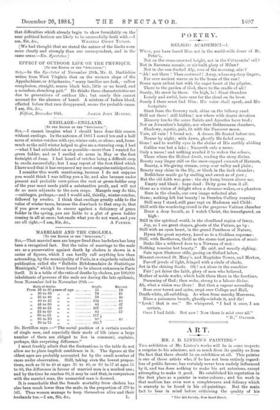MARRIAGE AND THE CHOLERA.
pro THE EDITOR OF THE "SPECTATOR-"]
Sfit,—That married men are longer-lived than bachelors has long been a recognised fact. But the value of marriage to the male sex as a preservative against death by cholera is shown in a series of figures, which I can hardly call anything less than astounding, by the municipality of Paris, in a singularly valuable publication called the "Bulletin Hebdomadaire de Statistique Mnnicipale," which I have found to be almost unknown in Paris itself. It is a table of the ratio of deaths by cho]era, per 100,000 inhabitants of persons of the male sex during the late epidemic, from November 3rd to November 29th :-
Ratio of deaths. Single. Atari ied.
From 25 to 30 years of age ... ...... 51 18 „ 30 to 35 78 21
II 35 to 40 33 71
58 40 „ 40 to 45 „ „ 152 44 „ 45 to 50 „ „ 83 47 „ 50 to 55 „ „ 167 37 „ 55 to 60 „ „ 83 57 „ 60 to 65 „ „ 117)
„ 65 to 70 „ „
89(c
46 .
,, 70 to 75 ,,,,
455)
Dr. Bertillon says :—" The social position of a certain number of single men, and especially their mode of life (since a large number of them are obliged to live in common), explains, perhaps, this surprising difference."
I must frankly admit that the fluctuations in the table do not allow me to place implicit confidence in it. The figures at the oldest ages are probably accounted for by the small number of eases under observation. Still, taking even the lowest proper- tions, such as 58 to 40 at ages 35 to 40, or 83 to 57 at ages 55 to 60, the difference in favour of married men is a marked one; and by the time be reaches 60, it may be said that, in comparison with the married man, the unmarried man is doomed.
It is remarkable that the female mortality from cholera has also been much lower than the male, in the proportion of 379 to 561. Thus women manage to keep themselves alive and their






































 Previous page
Previous page